Producing the Perfect Constant

Drone reeds are either the cause or the solution to the problem of creating a great sound out of three instruments (two tenors and a bass) simultaneously. That sounds like a tall order, and, frankly, it is. But, with some knowledge and strategy, anyone can produce at least a foundation for a great sound.
The Perfect Constant
In this crazy modern age of piping, I have found that few pipers, even at the highest levels, ever pause to consider what we are trying to do with a set of drones. To me, it's not about the reeds, the blowing, the squeezing, or even the set of drones that you play. These are all factors that play a role in the quality of a drone sound, but they do not constitute the bottom-line concept of "drones."
Drones are a backdrop for the pipe music that comes out of the chanter. They play the note "A," in several octaves, as well as a shocking number of more subtle "harmonics" that play at various frequencies. The reason we don't usually have cause to point them out is because they fuse seamlessly into the drone sound. And, this is especially true when the sound is well constructed and tuned.
A great drone sound is the perfect constant. It is a rich combination of the bass and two tenors, and all of the harmonics that layer underneath. Whenever there is a waver in the tone, or the tuning is even a split hair out, the constant disappears, and thus so does the whole point of the concept of "drones."
Your goal is to create this perfect constant for the chanter to play over top of.
Steady Blowing, Good Tuning, and a Good (rich, harmonious) sounding set of reeds are all ingredients for the perfect constant. Your goal, with the help of this article, is to put all of that together!
Let's start with some of the basics.
Drone Reed Basics
Upcoming are the parts of a drone reed - but first, let's talk about the difference between bass and tenor reeds.
Differences Between Bass and Tenor Reeds
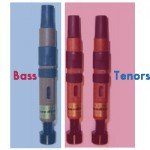 As far as the average Joe is concerned, the only difference between tenor reeds and bass reeds is their size and shape. Bass reeds are a bit longer, with a bigger/longer tongue and body. This is because it is will create a tone (with the help of the double-sized Bass Drone itself) that is a full octave below that of the tenors.
As far as the average Joe is concerned, the only difference between tenor reeds and bass reeds is their size and shape. Bass reeds are a bit longer, with a bigger/longer tongue and body. This is because it is will create a tone (with the help of the double-sized Bass Drone itself) that is a full octave below that of the tenors.
Other than these differences, you will find bass and tenors to be extremely similar, if not identical, in design.
While different makes of reeds are different in a variety of ways, they all have the same basic parts.
Basic Drone Reed Parts
(1) Body
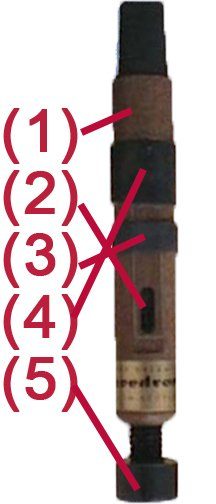 The "body" of the reed is the basic cylinder that the other parts connect to. It has a hollow inside, where the vibrations of the reed will resonate a bit before heading up into the drone.
The "body" of the reed is the basic cylinder that the other parts connect to. It has a hollow inside, where the vibrations of the reed will resonate a bit before heading up into the drone.
(2) Tongue
The tongue is the part of the reed that vibrates against the body to produce a musical tone. Sometimes it is connected to the body directly, but in most cases nowadays it is separate, and is held to the body with a bridle, or bridles.
(3) Bridle
The bridle is a band (usually rubber) that wraps around the tongue and body of the reed, and is used to adjust the "openness" or strength of the reed. Adjustments will also alter the pitch, because the inherent length of the tongue will change.
(4) Sub Bridle
Sometimes there is a secondary bridle that sort of "anchors" the tongue of the reed. This will be "above" (ie closer to the drone itself) the primary bridle. You won't be adjusting this often, if ever.
(5) Nose-cone/Screw
In the synthetic age, most synthetic reeds come with an adjustable end, in the form of a screw or a nose cone. These are used to tweak the tuning of the reed, which in turn affects where the drone tunes on the drone's slide itself.
As a quick example, the more a screw is turned in a reed, the shorter the inside of the body becomes, and therefore its overall pitch will be sharper. At this point, you know the drone itself will tune a bit higher on the slide (i.e. flatter), because the reed itself is producing a higher pitch.
Did you get that? If not, contact me any time, and I'll explain it further to you.
How to basically set up and fiddle with your drone reeds
Make sure the base of the reed is seated firmly in the reed seat.
Just like we talk about in our chanter reed guide AND our maintenance guide (see PipersDojo.com/free-guides), a tight seal is important. If the reed isn't seated firmly in the reed seat, air will find its way around the reed, instead of all of it going through the reed itself. Not only will this cause your bagpipe to leak, but also it will detract from the quality of sound you could have otherwise produced.
Use waxed hemp, and wrap that baby up tight!
Create a Life-Line
Unlike your chanter reed, which sits on top of the reed seat, your drone reeds are suspended from the bottom of your drone-seats. Therefore, if they come loose, they'll fall in!
To avoid this, you can build in a "lifeline" for your reed during the hemping process.
A lifeline is a tail of hemp that is designed to become pinned in between your drone and the stock, so that if your reed does come loose, it will dangle instead of falling into the bag.
Adjustment of the Bridle
As explained above, your bridle can (and needs to be) adjusted to the overall strength of your bagpipe. To do this, you'll make tiny adjustments up (towards the drone) or down (towards the bag). Upwards will increase the strength of the reed; downwards will decrease it. Careful here - a little adjustment goes a long way!
For more advanced strategy on reed bridle adjustment, keep reading. We go into way more depth in the Calibration section of the article.
Adjustment of the screw
Sometimes the drone is tuning in the wrong spot on the tuning slide. For instance, sometimes a tenor is tuning up so high that it is barely able to stay on! Or, maybe the bass is tuning so high that it won't start properly. Some folks even strive for an "optimal" position on the tuning pin to achieve the ultimate harmonic blend!
The tuning pin is good here to make adjustments of that sort. Shortening the inner chamber of the reed makes it sharper, thus the drone will tune higher on the pin. Lengthening the inner chamber of the reed makes it flatter, thus the drone will tune lower on the pin.
Types of Reeds
There are a million different brands of drone reeds out there. Very briefly though, I'll talk about the two main types.
Synthetic Reeds
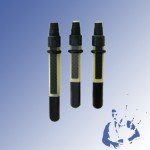 Synthetic Reeds are by far the dominant type of drone reed today in the world. They are made from various synthetic materials like plastic, carbon fiber, composites, etc. Because they are engineered exactly, they are very reliable in terms of steadiness.
Synthetic Reeds are by far the dominant type of drone reed today in the world. They are made from various synthetic materials like plastic, carbon fiber, composites, etc. Because they are engineered exactly, they are very reliable in terms of steadiness.
The main draw back with most synthetic reeds is that they handle the onset of moisture very poorly. Unlike the organic cane reed, there is nowhere for moisture to go when it starts to hit the reed, so it gathers on and around the tongue. This causes tuning problems, and this happens a lot sooner that most pipers like to admit.
Cane Reeds
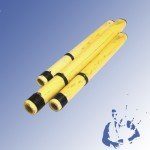 Cane reeds are still out there, but I think that this point it would be fair to say that this is a dying art. Cane reeds have a beautiful, natural, harmonic sound that has a depth that no synthetic reed can parallel (no matter what they say on the box).
Cane reeds are still out there, but I think that this point it would be fair to say that this is a dying art. Cane reeds have a beautiful, natural, harmonic sound that has a depth that no synthetic reed can parallel (no matter what they say on the box).
At the time this is written (2011), Field Marshal Montgomery is still at the top of the pipe band world playing cane reeds almost exclusively (at least, that is the widely accepted "word").
Cane reeds require a delicate balance of moisture to achieve the best, most stable sound. You have to really "know your bagpipe" to make these work. However, it can be done, and I would stress that when this challenge is overcome, cane still produces a sublime sound.
Oh, yeah - I almost forgot! Cane reeds are also extremely affordable. You can typically buy 5 cane sets for the price of 1 synthetic set.
Calibration: The Secret to a Great Drone Sound
Alright, this is the most important part of this article. I believe that, with perhaps 1 or 2 exceptions, any set of drone reeds, when well calibrated, can sound great.
Calibration is the art of setting up your reeds to take the perfect, most efficient amount of air so that they work together to produce a stable sound. The bottom line is: It’s all about matching, as precisely as possible, your drone reed strength to suit the strength of your chanter reed.
This idea is essential. Many times, we see students come in with reeds that are all taking different amounts of air, and all taking too much air relative to the strength of their reed. The result is a really loud, unsteady, un-tunable drone sound! If you read the Piper’s Dojo Maintenance Guide (available at PipersDojo.com/free-guides) you’ll learn that calibration is the final step in the maintenance process. You’ll also learn that good maintenance is at the base of the bagpipe tree of sound. Therefore, achieving good tone and tuning is IMPOSSIBLE without a well-set-up bagpipe, with well-calibrated drone reeds.
To achieve the most efficient (and resultantly most "solid") set-up, the drone reeds need to be matched perfectly to the strength of the chanter. Why? Here are two big reasons:
One: A chanter that is too easy relative to the drones means by definition an inefficient bagpipe.
This one's easy - if the drones are more open than they need to be, that means you're using more air, more moisture, and more energy than you need to operate your bagpipe.
Two: Drones that are too "open" will be less steady, thus will be harder to tune.
The more open a drone reed is, the more they will change with changes in pressure. Therefore, they'll be harder to "lock" in with each other if they are more open than they need to be.
How to Calibrate
So, that was a quick explanation of why you need to calibrate. Now, let's get to how to do it. Here's how we suggest you calibrate your drone reeds.
Step 1
First, cork off your bass and a tenor. Play Low A on your chanter with one drone going. Your drone reed should shut off when you blow too hard on your chanter. Gradually increase your blowing pressure until you know you're blowing too hard. Does the reed shut off? It should.
Here's why: If your drone reed shuts off when you blow too hard on your chanter, you know it's taking the minimum amount of air necessary when you're blowing normally. This is essential in trying to achieve an efficient bagpipe!
If your drone doesn't shut off, adjust the bridle on the drone reed down, towards the end of the tongue. Most synthetic reeds will only need the slightest adjustment (too much and the reed won't sound at all). If, by chance, your reed is shutting off too soon, adjust the bridle away from the tip of the tongue.
Note: if you aren't sure how to do this, be sure to have a teacher show you a couple of times. Reeds are expensive, so you need to be careful not to damage them in the process of adjusting the bridles. It’s not hard, but it’s worth being shown a time or two.
Step 2
Ok, now that the first reed is calibrated, our objective is going to be to calibrate the other two drone reeds to the same strength of the first.
I would cork off the chanter, and then open up a second drone. Now, we'll gradually increase the pressure in the bag, in hopes that the two drones will shut off at exactly the same pressure.
Do they? If the "new" (recently opened) drone shuts off later than the first, you'll need to close it down a bit, by moving the bridle towards the tip of the tongue. If it shuts off too early, move the bridle away from the tip of the tongue. When they shut off at exactly the same pressure, then move on to the third drone and perform the same task.
The reason we want them to shut off at the same time is this: Obviously, the principle from above still applies - if all the drone reeds shut off when you blow too hard, that means when you blow normally, the reeds are taking the minimum amount of air. Now, we add in the extra step - if the drone reeds are all taking the SAME amount of air, that means they will all react the SAME to changes in blowing. They'll be steadier, stay in tune, and take on the same amount of moisture. Try it! It really works!
After this process, your pipes are guaranteed to be as efficient as possible. Cover your bases with good maintenance as well (see the Piper’s Dojo Maintenance Guide for that at PipersDojo.com/free-guides), and you’ll have a bagpipe as stable and efficient as the pros!
The Endless Battle with Moisture
Keep moisture off the reeds!
This is especially important with most synthetic reeds. Condensation on the tongue makes the reeds vibrate unpredictably. Whenever a droplet moves on the tongue, your drones will go out of tune.
This is an extremely in-depth topic, but consider a few simple strategies:
- Make sure your bag is seasoned properly. Seasoning helps subdue moisture issues in the bag
- If you play a moisture-control system like a canister bag, make sure the "rocks" are dry.
- About ten minutes before a performance, check the reeds for condensation. If there's a lot, wipe it off, then minimize the amount of air you put through them before you have to perform.
- Avoid cold environments. Even a few moments in a cold space could cause moisture in your bag to condense!!! On the same note, be aware that the colder the environment, the more moisture you'll have forming on your drone reeds.
The Perfect Constant - Mission Accomplished?
I hope that this article has helped you to achieve your perfect constant.
I think one of the great ironies of this topic is this: the closer you come to your perfect constant, the more discerning your ear becomes. Eventually, you realize that perfection is really going to be hard to achieve (if it can ever be achieved).
I have experienced the perfect constant for a few brief moments in my own career, and I have heard it in others several times as well. It seems perfect at the time, but it’s not. It’s simply a moment where you realize another whole degree of tuning quality and bagpipe steadiness is possible. Then, knowing that, you set out to get that for yourself - and it’s a long, yet amazing, journey.
At the Piper’s Dojo, we work hard to try to get people to see how bagpiping is more than just a hobby - it’s a way to improve ourselves, and a way of life. I believe that the lesson that is uncovered in searching for the perfectly calibrated set of drone reeds exposes the truth in our Core Philosophy. Just like life, we must methodically strive for perfection, knowing it’s unlikely (if not impossible) to ever achieve it.
This article was first published in The Voice Magazine in Winter 2011.
Take Action
If you're a Dojo student, make sure you've worked your way through our 11 Commandments of Mastery course, and then start looking at our Tune of the Week each week as part of the Bagpipe Freedom program.
If you're not yet a Dojo Student, we'd love to welcome you! You can take the 11 Commandments course, or explore our monthly membership options and join us as a student, where you can vary your repertoire in a guided way with hundreds of other pipers around the world cheering you on!

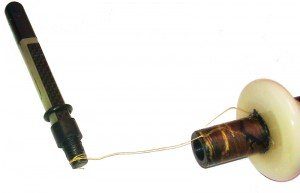



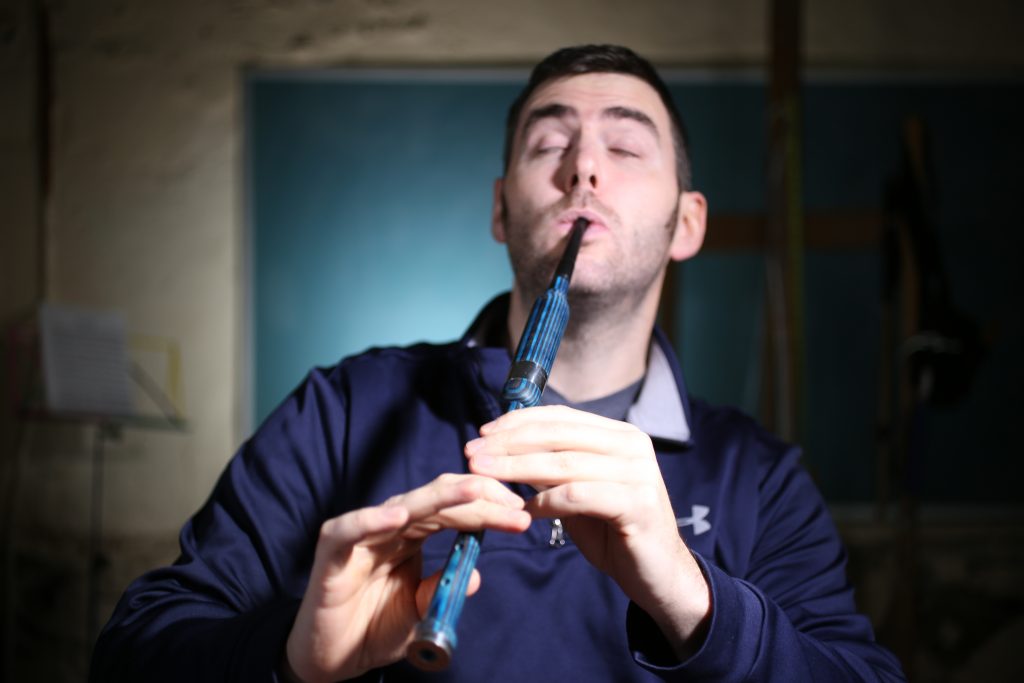

Another GREAT article on a very important subject. Thank you again Andrew and Dojo U.